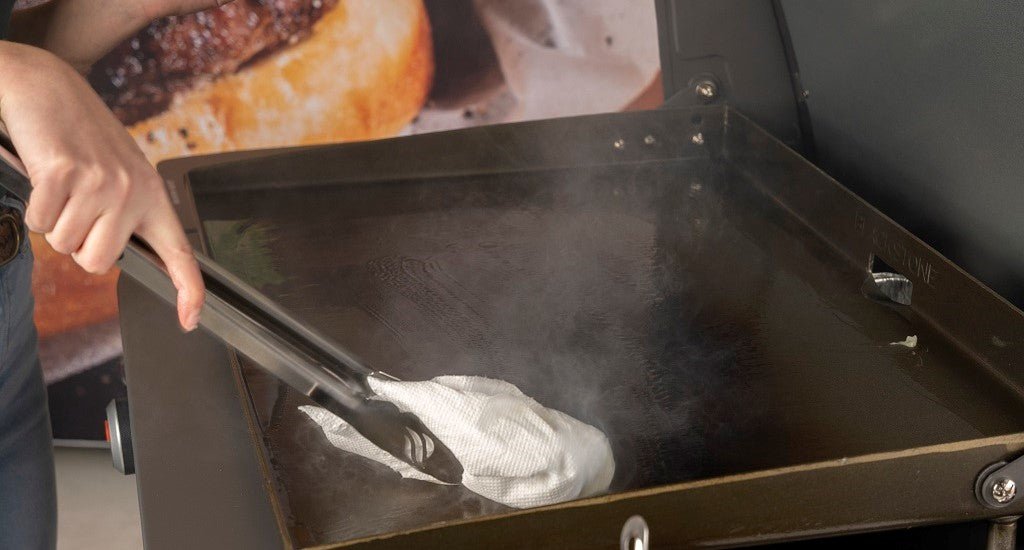
How often does a griddle need to be seasoned?
Whether you are firing up your Blackstone griddle for the first time or you are a veteran user, at some point your griddle surface will need seasoning. Fortunately, the process of seasoning and maintaining a properly seasoned griddle is simple. Here are some tips for keeping your griddle looking good and cooking delicious foods every time you use it.
All Blackstone gas griddles come with an unseasoned flat-top grill surface made of cold-rolled steel.
Steel is an optimal surface for cooking on because it’s heavy-duty, it conducts heat well, and when seasoned properly, it provides an almost non-stick surface. Seasoning your griddle provides a hardened surface like a shell that protects the griddle over time.
How do you season your Blackstone Griddle for the first time?
We’ve written a comprehensive guide on how to season a Blackstone griddle for the first time and also have a variety of videos on the topic, but as a refresher, here are a few bullet points:
Start with a sponge bath: Starting with a clean griddle is the first step to getting it properly seasoned. Using de-greasing dish soap, make up a batch of mildly soapy warm water and wash the surface down with a sponge to release any existing oils or manufacturing debris. Then give it a good rinse with clean water to make sure all the soap has been washed away.
Heat your clean griddle surface: Your newly cleaned griddle surface will need to be completely dry, so fire up the burners and let them run for a good 10-15 minutes. This will burn off the water and make the flat-top griddle ready to accept the seasoning. It will likely start browning which is a good thing! Treat yourself with a cold beverage for what you’ve accomplished this far.
Add oil or griddle conditioner to the surface: When the griddle has cooled, it’s time to spread the thinnest coat of Blackstone Griddle Seasoning & Cast Iron Conditioner or your favorite cooking oil across the entire griddle surface. Be sure to wipe up any droplets of oil or pooling then turn the heat back on. Allow it the oil or conditioner to cook for 10-15 minutes or until it stops smoking.
Repeat the seasoning process: When you cook three to four coats of seasoning into the griddle surface, it will become dark black and smooth. This is an indication that the griddle is seasoned and you’re ready to get cooking.
How do you maintain the griddle seasoning between uses?
The griddle seasoning is essentially a hardened shell that lives on your griddle surface. Although there isn’t a lot you need to do between uses, there are some best practices you can do to prolong the longevity of the griddle seasoning after each use.
For this, you will need water, a sturdy scraper, some tongs, a good amount of paper towels, and a small amount of neutral cooking oil.
- After you are done cooking, scrape any food particles, oils, and liquids from the griddle surface and discard
- Pour some water on the griddle surface
- Turn the burners on a low-to-medium heat and use the scraper to move the water so it picks up any oils or smaller food particles as it evaporates
- Discard any sludge and repeat by adding water to the surface as needed to remove debris until clean
- When the griddle surface is completely free of debris, oils, and water, add about a tablespoon of oil
- Using paper towels and tongs, spread the oil in the thinnest coat possible, taking care to wipe up any drops or pooling
- Allow the griddle to cool and cover
Is there anything to avoid cooking on a griddle?
Although there isn’t really anything you should avoid cooking on a flat top grill, different foods will react differently with the surface and you should be aware of them.
- Sugary sauces like barbecue, teriyaki, and sweet and sour will reduce and the flavors will become concentrated and likely burn. Instead of adding them to foods initially, save the sugary sauces and add them just before your food is done cooking so they have less time to burn.
- The acidity in foods like lemons, limes, tomatoes, tomato sauce, and vinegar can actually start to clean the griddle and degrade your seasoning in the process. Be sure to use plenty of water when you’re cleaning up after cooking acidic foods, and wipe it down with a little oil when you’re done.
- Bacon may be magically delicious when cooked on a griddle, but it can wreak havoc because it often contains sugar or artificial flavoring that can caramelize and eventually burn onto the griddle. Fortunately, it can be quickly cleaned with plenty of scraping and a bit of water.
Although the initial seasoning is something that’s required of all gas griddles, with some routine cleaning and maintenance it shouldn’t have to be re-seasoned again. If your seasoning becomes a problem or needs more maintenance than our suggestions here, consider the Blackstone professional griddle cleaning kit that’s capable of revitalizing even the most stubborn surfaces.

